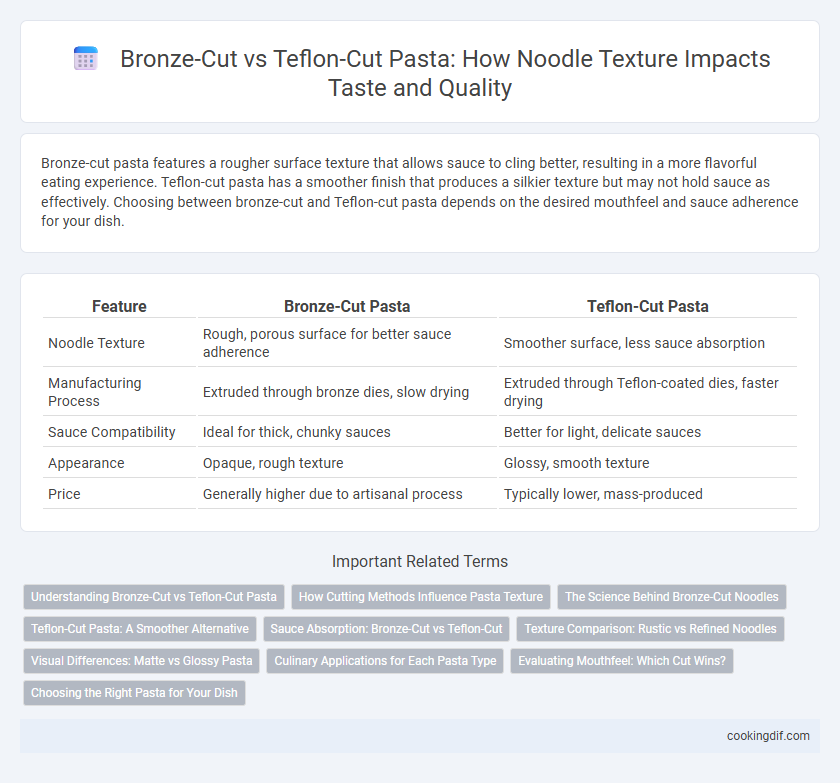Bronze-cut pasta features a rougher surface texture that allows sauce to cling better, resulting in a more flavorful eating experience. Teflon-cut pasta has a smoother finish that produces a silkier texture but may not hold sauce as effectively. Choosing between bronze-cut and Teflon-cut pasta depends on the desired mouthfeel and sauce adherence for your dish.
Table of Comparison
| Feature | Bronze-Cut Pasta | Teflon-Cut Pasta |
|---|---|---|
| Noodle Texture | Rough, porous surface for better sauce adherence | Smoother surface, less sauce absorption |
| Manufacturing Process | Extruded through bronze dies, slow drying | Extruded through Teflon-coated dies, faster drying |
| Sauce Compatibility | Ideal for thick, chunky sauces | Better for light, delicate sauces |
| Appearance | Opaque, rough texture | Glossy, smooth texture |
| Price | Generally higher due to artisanal process | Typically lower, mass-produced |
Understanding Bronze-Cut vs Teflon-Cut Pasta
Bronze-cut pasta features a rough, porous surface created by bronze dies that allows sauce to cling better, enhancing texture and flavor absorption. Teflon-cut pasta, produced with non-stick Teflon dies, has a smoother finish resulting in a silkier texture but less sauce adherence. Understanding these differences helps chefs and home cooks select pasta types that optimize sauce retention and mouthfeel in various dishes.
How Cutting Methods Influence Pasta Texture
Bronze-cut pasta boasts a rough, porous surface that allows sauce to cling better, enhancing flavor absorption and providing a hearty bite, while Teflon-cut pasta features a smooth, sleek texture that results in a more delicate mouthfeel but less sauce adherence. The bronze dies create microscopic grooves and ridges on each noodle, crucial for capturing thicker sauces like ragu or pesto, whereas Teflon dies yield a polished finish suited for lighter, olive oil-based dressings. Choosing between bronze-cut and Teflon-cut pasta fundamentally impacts the eating experience by altering sauce retention and noodle firmness.
The Science Behind Bronze-Cut Noodles
Bronze-cut noodles have a rougher surface due to the bronze dies used during extrusion, which increases pasta's porosity and allows sauces to cling better, enhancing flavor absorption. Unlike smooth Teflon-cut pastas, the microscopic grooves in bronze-cut noodles create increased friction, resulting in a firmer bite and improved texture. This textured surface is achieved through slower extrusion and oxidization, influencing water absorption and pasta cooking behavior on a molecular level.
Teflon-Cut Pasta: A Smoother Alternative
Teflon-cut pasta produces smoother noodles with a polished surface, reducing sauce adherence compared to bronze-cut varieties. This manufacturing technique uses non-stick Teflon dies, creating strands that are less porous and have a glossy finish. While bronze-cut pasta offers a rough texture for better sauce grip, Teflon-cut pasta is preferred for delicate dishes where a sleek appearance and tender bite are desired.
Sauce Absorption: Bronze-Cut vs Teflon-Cut
Bronze-cut pasta features a rough, porous surface that enhances sauce absorption, allowing flavors to cling better to each noodle. Teflon-cut pasta has a smoother finish, which results in less sauce adhesion and a slick texture that can cause sauces to slide off. The choice between bronze-cut and Teflon-cut significantly impacts the overall mouthfeel and flavor intensity of the pasta dish.
Texture Comparison: Rustic vs Refined Noodles
Bronze-cut pasta has a rough, porous texture that allows sauces to cling better, creating a rustic, hearty mouthfeel ideal for traditional Italian dishes. Teflon-cut pasta, with its smooth and polished surface, produces noodles with a refined, sleek texture that is perfect for delicate sauces and lighter preparations. The choice between bronze-cut and Teflon-cut significantly influences the overall dining experience by enhancing texture interaction with sauces and creating distinct sensory profiles.
Visual Differences: Matte vs Glossy Pasta
Bronze-cut pasta features a rough, matte surface that enhances sauce adhesion, creating a more authentic and rustic texture. In contrast, Teflon-cut pasta has a smooth, glossy finish, resulting in a sleek appearance but less sauce retention. The distinct visual difference--matte versus glossy--directly influences the overall eating experience and presentation of the noodle.
Culinary Applications for Each Pasta Type
Bronze-cut pasta features a rougher surface that better absorbs sauces, making it ideal for hearty ragus and thick, chunky sauces where sauce adherence is key. Teflon-cut pasta has a smoother texture, suitable for delicate, light sauces such as olive oil or butter-based dressings, allowing the pasta's shape and flavor to shine without overpowering the dish. Culinary applications capitalize on bronze-cut pasta for robust, rustic preparations, while Teflon-cut pasta complements refined, simple recipes emphasizing pasta texture and subtle ingredients.
Evaluating Mouthfeel: Which Cut Wins?
Bronze-cut pasta boasts a rougher surface texture that clings better to sauces and delivers a chewier, more artisanal bite, enhancing the overall mouthfeel. In contrast, Teflon-cut pasta has a smoother, silkier texture resulting in a more delicate, less resistant chew, often perceived as less complex. Evaluating mouthfeel, bronze-cut pasta wins for those seeking a robust, textured noodle experience, while Teflon-cut suits preferences for lighter, smoother pasta.
Choosing the Right Pasta for Your Dish
Bronze-cut pasta has a rough, porous texture that helps sauce cling better, enhancing flavor absorption and creating a more authentic Italian experience. Teflon-cut pasta results in a smoother surface, ideal for lighter sauces or seafood dishes where a delicate texture is preferred. Selecting bronze-cut pasta for rich, hearty sauces and Teflon-cut for subtle, creamy preparations ensures optimal noodle texture and flavor harmony.
bronze-cut vs Teflon-cut for noodle texture Infographic

 cookingdif.com
cookingdif.com